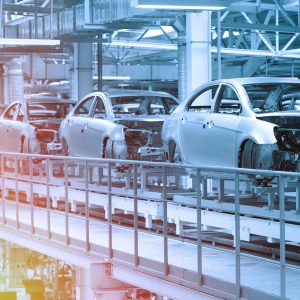
The automotive industry has been waiting for this. Bring us a way to rapidly prototype, test, try, and deny, all in the span of a few weeks. Suddenly the innovation of parts has a whole new persona. Lightweight with strength? You got it. How about metal materials? Quite possible.
Additive manufacturing has been a tacit boon for manufacturing, especially for its largest segment: automotive. Additive manufacturing and 3-D printing are used in assembly, design, and in finished goods inventory. Its flexibility makes for many possibilities from design through fabrication and assembly.
Flexibility for Assembly
During assembly, auto manufacturers have used 3-D printing to custom fabricate jigs and guides used in specific installation not possible by a robotics movement or other automated step. A 3-D printed jig, for example, may be used to help align bolt holes with an installed piece. This and other jigs could be custom fabricated as guides to help installers with assembly.
Earlier in the design phase, additive manufacturing may be used to rapidly prototype a part or component, according to a design to test and try different design iterations. For example, different configurations may be designed with specific attributes from an additive material to check for clearances, functionality, and mechanical integrity as used in a specific sub-assembly.
Flexibility in Design

Using this approach for design is ideal for rapid prototyping. There’s no need to wait to machine, forge, or cast a metal piece as a prototype when one can be produced in minutes with additive manufacturing. What’s more, different designs may be iterated, tried, and corrected until the precise configuration is arrived at—in short order, and inexpensively.
For instance, a major auto manufacturer previously made a bracket as part of its braking systems by stamping metal. The process was somewhat cumbersome and time consuming. Instead, they turned to additive manufacturing to create the part from a durable polymer material engineered with tantamount properties that the stamped steel provided. Additive manufacturing allows more control of the process and provides more options: feedstock material may change and so can the bracket design after quality checks or for any other reason.
Flexibility in Fabrication
Another way that additive manufacturing and 3-D printing are being used in automotive goes beyond jigs, guides, and design prototypes. Some products, particularly custom parts and those required in smaller quantities, may be custom fabricated with 3-D printing in bulk. 3-D printing and additive manufacturing may produce parts and components in fast and repetitive production. This allows more flexibility in the process.
Additive manufacturing is creating an unprecedented flexibility for automotive manufacturing in an industry that’s been seeking “the better mousetrap” since it began. If a design is to change midstream, or if a new material is discovered or desired to be tried, it may be accomplished easily and without much of the retooling that would be required in traditional fabrication and assembly.
Deloitte, in their article, emphasized the value in this approach:
“From a business standpoint, prototyping physical parts is very costly, so the more we can do to validate a component in the digital space, the more we can control our costs. We obviously must maintain robust physical validation capabilities to ensure performance requirements are met, but there are huge benefits from being able to do some of the work upfront using digital tools. In fact, we can simulate all input parameters for a given component before we print it.”
Additive Manufacturing: A New Opportunity?
Summarily, additive manufacturing for the automotive industry is just warming up. But its flexibility and many uses are welcomed as a solution to many manufacturing challenges and dilemmas faced by today’s ever-challenged global automotive industry. Additive manufacturing adds value.
Deloitte, in their article, may have said it best:
“Additive manufacturing is an opportunity to differentiate via unique designs and economy of production.”
